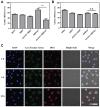Nucleolin-Targeting AS1411 Aptamer-Modified Micelle for the Co-Delivery of Doxorubicin and miR-519c to Improve the Therapeutic Efficacy in Hepatocellular Carcinoma Treatment
- PMID: 33833512
- PMCID: PMC8019667
- DOI: 10.2147/IJN.S304526
Nucleolin-Targeting AS1411 Aptamer-Modified Micelle for the Co-Delivery of Doxorubicin and miR-519c to Improve the Therapeutic Efficacy in Hepatocellular Carcinoma Treatment
Abstract
Background: Multidrug resistance (MDR) has emerged to be a major hindrance in cancer therapy, which contributes to the reduced sensitivity of cancer cells toward chemotherapeutic drugs mainly owing to the over-expression of drug efflux transporters. The combination of gene therapy and chemotherapy has been considered as a potential approach to improve the anti-cancer efficacy by reversing the MDR effect.
Materials and methods: The AS1411 aptamer-functionalized micelles were constructed through an emulsion/solvent evaporation strategy for the simultaneous co-delivery of doxorubicin and miR-519c. The therapeutic efficacy and related mechanism of micelles were explored based on the in vitro and in vivo active targeting ability and the suppression of MDR, using hepatocellular carcinoma cell line HepG2 as a model.
Results: The micelle was demonstrated to possess favorable cellular uptake and tumor penetration ability by specifically recognizing the nucleolin in an AS1411 aptamer-dependent manner. Further, the intracellular accumulation of doxorubicin was significantly improved due to the suppression of ABCG2-mediated drug efflux by miR-519c, resulting in the efficient inhibition of tumor growth.
Conclusion: The micelle-mediated co-delivery of doxorubicin and miR-519c provided a promising strategy to obtain ideal anti-cancer efficacy through the active targeting function and the reversion of MDR.
Keywords: aptamer; micelle; multidrug resistance; nucleolin; tumor targeting.
© 2021 Liang et al.
Conflict of interest statement
The authors report no conflicts of interest in this work.
Figures








Similar articles
-
Modified AS1411 Aptamer Suppresses Hepatocellular Carcinoma by Up-Regulating Galectin-14.PLoS One. 2016 Aug 5;11(8):e0160822. doi: 10.1371/journal.pone.0160822. eCollection 2016. PLoS One. 2016. PMID: 27494117 Free PMC article.
-
Innovative gelatin-based micelles with AS1411 aptamer targeting and reduction responsiveness for doxorubicin delivery in tumor therapy.Biomed Pharmacother. 2024 May;174:116446. doi: 10.1016/j.biopha.2024.116446. Epub 2024 Mar 20. Biomed Pharmacother. 2024. PMID: 38513599
-
Cell Surface Nucleolin as a Promising Receptor for Effective AS1411 Aptamer-Mediated Targeted Drug Delivery into Cancer Cells.Curr Drug Deliv. 2018;15(9):1323-1329. doi: 10.2174/1567201815666180724104451. Curr Drug Deliv. 2018. PMID: 30039760
-
Multifunctional micelle delivery system for overcoming multidrug resistance of doxorubicin.J Drug Target. 2018 Apr;26(4):289-295. doi: 10.1080/1061186X.2017.1379525. Epub 2017 Sep 21. J Drug Target. 2018. PMID: 28901798 Review.
-
Discovery and development of the G-rich oligonucleotide AS1411 as a novel treatment for cancer.Exp Mol Pathol. 2009 Jun;86(3):151-64. doi: 10.1016/j.yexmp.2009.01.004. Epub 2009 Jan 20. Exp Mol Pathol. 2009. PMID: 19454272 Free PMC article. Review.
Cited by
-
Aptamer-engineered (nano)materials for theranostic applications.Theranostics. 2023 Sep 25;13(15):5183-5206. doi: 10.7150/thno.85419. eCollection 2023. Theranostics. 2023. PMID: 37908725 Free PMC article. Review.
-
Codelivery of TGF-β1 and anti-miR-141 by PLGA microspheres inhibits progression of intervertebral disc degeneration.J Orthop Surg Res. 2023 Jan 6;18(1):17. doi: 10.1186/s13018-023-03501-5. J Orthop Surg Res. 2023. PMID: 36609253 Free PMC article.
-
Application of aptamer functionalized nanomaterials in targeting therapeutics of typical tumors.Front Bioeng Biotechnol. 2023 Feb 16;11:1092901. doi: 10.3389/fbioe.2023.1092901. eCollection 2023. Front Bioeng Biotechnol. 2023. PMID: 36873354 Free PMC article. Review.
-
miRNAs as short non-coding RNAs in regulating doxorubicin resistance.J Cell Commun Signal. 2023 Dec;17(4):1181-1202. doi: 10.1007/s12079-023-00789-0. Epub 2023 Nov 29. J Cell Commun Signal. 2023. PMID: 38019354 Free PMC article. Review.
-
Polymeric-Micelle-Based Delivery Systems for Nucleic Acids.Pharmaceutics. 2023 Jul 26;15(8):2021. doi: 10.3390/pharmaceutics15082021. Pharmaceutics. 2023. PMID: 37631235 Free PMC article. Review.
References
MeSH terms
Substances
LinkOut - more resources
Full Text Sources
Other Literature Sources

